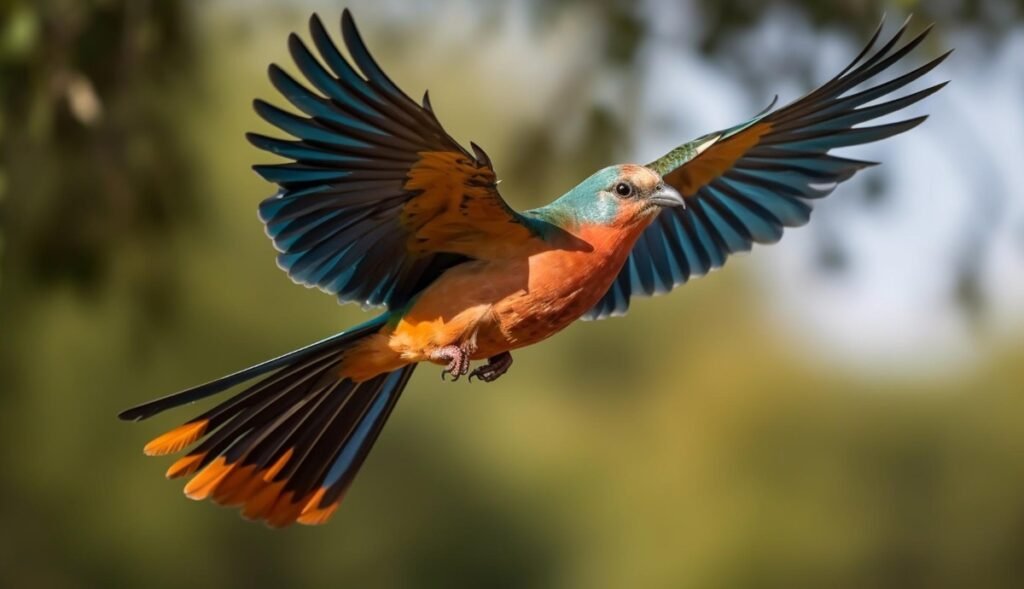The natural world is full of fascinating phenomena, and one of the most intriguing is the difference in plumage coloration between male and female birds. While both sexes exhibit vibrant colors, it’s undeniable that males tend to be more colorful than their female counterparts. This phenomenon has sparked curiosity among ornithologists, scientists, and bird enthusiasts alike, leading to numerous studies and theories attempting to explain this disparity.
Why Are Male Birds More Colorful Than Female Birds?
In this overview, we’ll delve into the possible reasons behind this phenomenon, exploring the evolutionary pressures, mating strategies, and social behaviors that contribute to the striking coloration of male birds. We’ll also examine the role of sexual selection, predation, and environmental factors in shaping the plumage of our feathered friends.
Evolutionary Pressures
One of the primary drivers of male birds’ coloration is the need to attract mates. In many species, males engage in elaborate courtship displays, showcasing their vibrant plumage to potential partners. This visual display serves as a signal of fitness, health, and genetic quality, increasing the chances of successful mating and reproduction. Female birds, on the other hand, tend to focus on finding a suitable mate with a strong immune system and good genes, rather than relying solely on visual cues.
Mating Strategies
Males’ colorful plumage also plays a crucial role in establishing dominance and territory. In many species, males engage in aggressive displays, using their bright colors to intimidate rivals and defend their territory. This competition for resources and mating opportunities drives the evolution of more vibrant colors in males, as they strive to outdo their rivals and attract more mates.
Sexual Selection
Sexual selection, a key concept in evolutionary biology, refers to the process by which individuals with desirable traits are more likely to mate and pass those traits on to their offspring. In the case of male birds, their colorful plumage serves as a signal of fitness and attractiveness, increasing their chances of mating and reproduction. This selective pressure drives the evolution of more striking colors in males, as females are more likely to choose mates with these desirable traits.
Predation and Environmental Factors
Finally, predation and environmental factors also play a role in shaping the plumage of male birds. In some species, males’ bright colors may serve as a warning signal to potential predators, signaling that they are less palatable or more difficult to catch. Environmental factors, such as diet and climate, can also influence the development and maintenance of colorful plumage in males.
In conclusion, the phenomenon of male birds being more colorful than female birds is a complex and multifaceted one, driven by a combination of evolutionary pressures, mating strategies, sexual selection, and environmental factors. By understanding the underlying mechanisms, we can gain a deeper appreciation for the fascinating world of birds and the intricate strategies they employ to survive and thrive in their environments. (See Also: How Many Birds Make A Flock)
Why Are Male Birds More Colorful Than Female Birds?
Birds are one of the most diverse and fascinating groups of animals on the planet, with over 10,000 different species spread across the globe. One of the most striking features of birds is their incredible range of colors and patterns, which play a crucial role in their behavior, communication, and mating strategies. In this article, we’ll explore the reasons why male birds are often more colorful than their female counterparts.
The Role of Coloration in Bird Communication
Coloration is a vital component of bird communication, and it serves several purposes. For example, bright colors can be used to signal aggression, courtship, or warning calls to potential predators. In many bird species, males are more colorful than females because they use their plumage to advertise their health, strength, and genetic quality to potential mates. This is known as “sexual selection,” where males compete for mating opportunities by displaying their most vibrant and striking colors.
Take, for example, the peacock’s stunning tail feathers. The bright blues and greens of the peacock’s plumage are a visual display of its genetic quality and health, which helps to attract females and deter rival males. Similarly, the vibrant colors of the male cardinal’s plumage serve as a signal of its fitness and suitability as a mate.
The Evolution of Coloration in Birds
The evolution of coloration in birds is a complex process that has been shaped by millions of years of natural selection. In many bird species, the development of bright colors is linked to the production of melanin, a pigment that is responsible for the production of brown and black colors. However, some bird species have evolved to produce bright colors through the production of carotenoid pigments, which are derived from the diet.
For example, the bright yellow and orange colors of the canary’s plumage are derived from the carotenoid pigments found in its diet of seeds and fruits. Similarly, the bright red colors of the cardinal’s plumage are produced by the carotenoid pigments found in its diet of seeds and berries.
Sexual Dimorphism in Birds
Sexual dimorphism refers to the differences in appearance between males and females of the same species. In many bird species, males are more colorful than females because of the presence of certain hormones, such as testosterone, which stimulate the production of bright colors.
For example, the male red-winged blackbird has a bright red and yellow patch on its wings, which is produced by the presence of testosterone. In contrast, the female red-winged blackbird has a duller, more subdued plumage. Similarly, the male northern cardinal has a bright red plumage, while the female has a more subdued brownish-red plumage. (See Also: How Many Lungs Do Birds Have)
Why Are Female Birds Less Colorful Than Males?
So, why are female birds less colorful than males? There are several reasons for this. One reason is that females often have different mating strategies than males. While males may compete for mating opportunities by displaying their bright colors, females may use other strategies, such as vocalizations or courtship displays, to attract mates.
Another reason is that females may not need to advertise their genetic quality or health as much as males. In many bird species, females are choosy about their mates and may select males based on other criteria, such as song quality or dominance status. As a result, females may not need to display bright colors to attract mates.
Conclusion
In conclusion, male birds are often more colorful than females because of the role of coloration in bird communication, the evolution of coloration in birds, and sexual dimorphism. While females may not need to advertise their genetic quality or health as much as males, they may use other strategies to attract mates. Understanding the reasons behind the differences in coloration between male and female birds can provide valuable insights into the behavior and ecology of these fascinating creatures.
Key Points
- Male birds are often more colorful than females due to the role of coloration in bird communication.
- The evolution of coloration in birds is linked to the production of melanin and carotenoid pigments.
- Sexual dimorphism refers to the differences in appearance between males and females of the same species.
- Females may not need to advertise their genetic quality or health as much as males.
- Females may use other strategies to attract mates, such as vocalizations or courtship displays.
Recap
In this article, we explored the reasons why male birds are often more colorful than their female counterparts. We discussed the role of coloration in bird communication, the evolution of coloration in birds, and sexual dimorphism. We also examined the reasons why females may not need to advertise their genetic quality or health as much as males and may use other strategies to attract mates. By understanding the reasons behind the differences in coloration between male and female birds, we can gain valuable insights into the behavior and ecology of these fascinating creatures.
Why Are Male Birds More Colorful Than Female Birds: FAQs
Why do male birds need to be more colorful than females?
Male birds often need to be more colorful than females to attract mates and establish dominance within their species. Bright colors and striking plumage can serve as a visual signal to potential mates, indicating the male’s health, genetic quality, and ability to provide for offspring. In some species, males may also use their bright colors to intimidate rivals and defend their territory.
Do all bird species follow this pattern of male coloration being more vibrant than female?
No, not all bird species follow this pattern. In some species, such as peacocks and some species of ducks, females are more brightly colored than males. In other species, such as hummingbirds, both males and females can be equally colorful. The pattern of male coloration being more vibrant than female can vary greatly across different bird species and even within the same species. (See Also: How To Keep Birds From Crashing Into Windows)
Is there a specific reason why male birds tend to be more colorful than female birds in many species?
Yes, there are several reasons why male birds tend to be more colorful than female birds in many species. One reason is that males often have a greater need to attract mates and establish dominance, which requires them to stand out visually. Additionally, males may have a greater investment in their reproductive success, as they often provide most of the parental care in many bird species. As a result, males may have evolved to be more colorful to increase their chances of attracting a mate and successfully raising offspring.
Can you give an example of a bird species where the female is more colorful than the male?
A great example is the Argus pheasant, where the female is more brightly colored than the male. The female Argus pheasant has vibrant green and blue plumage, while the male is more subdued in color. This is unusual, as most bird species follow the pattern of the male being more colorful than the female.
Is there any evidence that female birds have evolved to be less colorful than males due to natural selection?
Yes, there is evidence that female birds have evolved to be less colorful than males due to natural selection. In many species, females may have evolved to be less colorful because they do not need to attract mates or establish dominance in the same way as males. Instead, females may focus on finding a high-quality mate and ensuring their offspring’s survival, which may not require the same level of visual display as males. As a result, natural selection may favor females that are less colorful and more focused on other aspects of their reproductive success.


